You may have seen photos from the mock-up train design back in October.
It’s been part of a consultation process over about the past year, which has concluded.
As the Herald Sun reported on the weekend (pay wall), the finishing touches are now being put on the design.
Yesterday on behalf of the PTUA, I got to see the revised version of the mock-up. Here are some pics.
As you can see, it’ll be a 7-car train, providing 510 seats – about the same number as the current trains, but far more overall space.
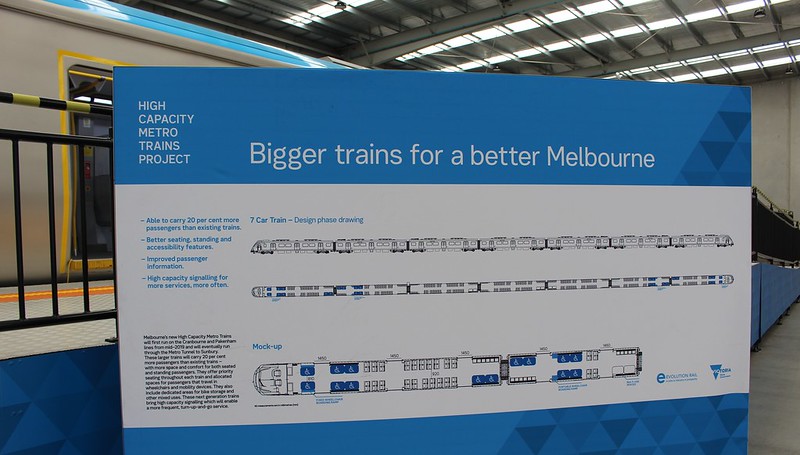
The streamlined design is quite appealing, and is really a consequence of the coupler cover, to help prevent train surfing, as well as the front being designed to cushion any impact from a collision.
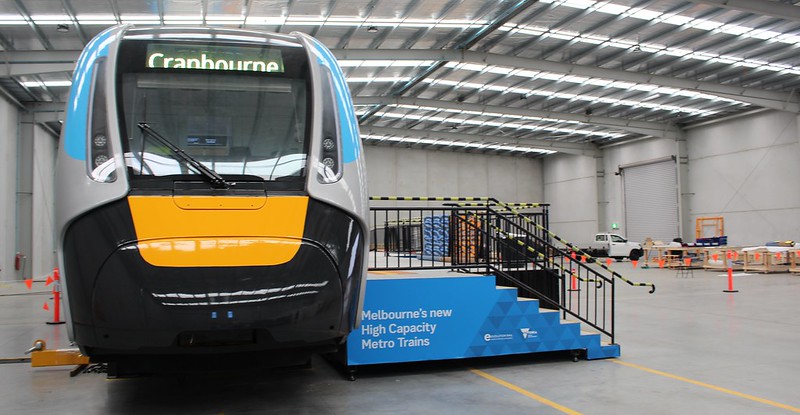
Emergency evacuation ladders will make it easier to get everybody out of the train if ever necessary.
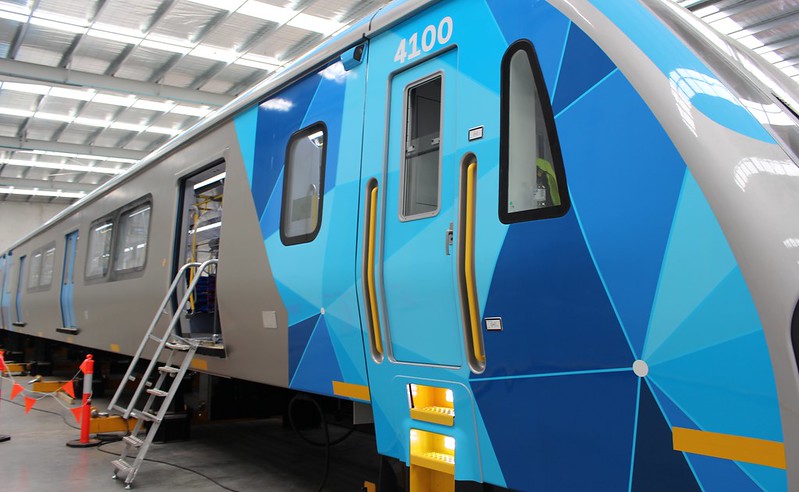
There’s been extensive consultation with train drivers, and the entire console got a thorough re-design at one stage. There’s also lots of CCTV, accessible by the driver, and recording constantly. Naturally the cab is capable of being fitted with in-cab signalling equipment when that is rolled-out.
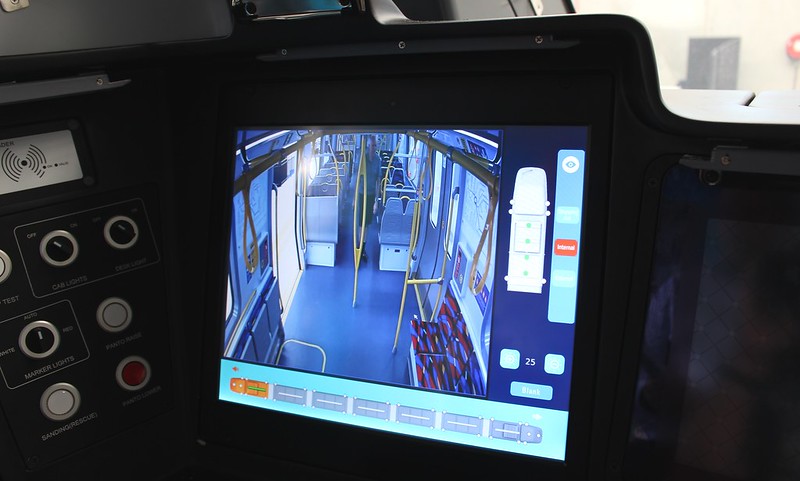
The seat fabrics have changed a bit. The orange design shown here on the left will be for priority seating (aligned with the standard colour being used throughout PTV services); the blue is for other seats. Not all the seats inside the mock-up have the new fabric at this stage.
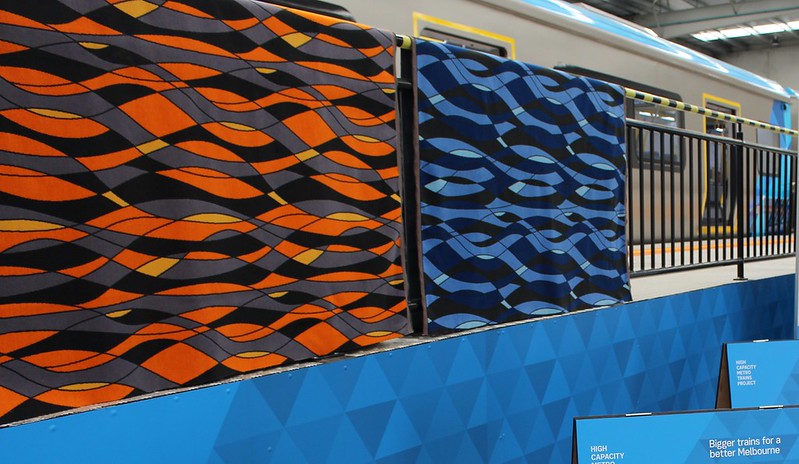
The backs of the seats are treated to reduce vandalism.
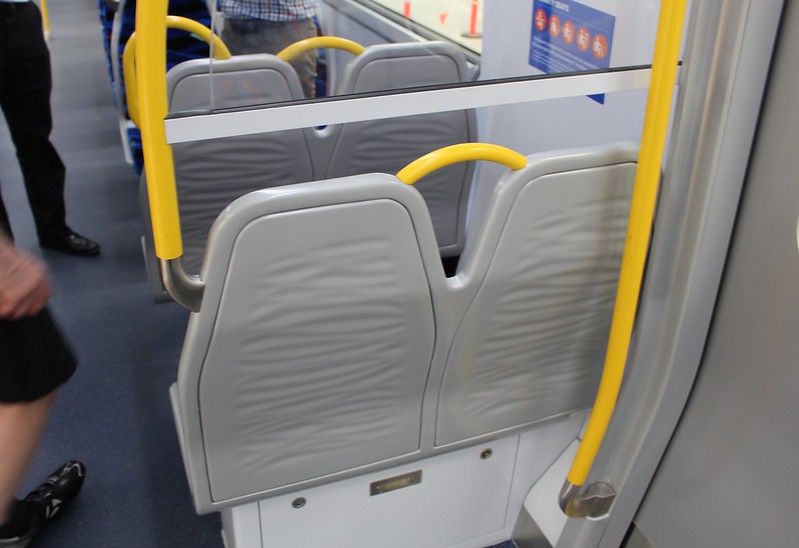
Priority seats are marked more clearly, and passenger intercoms can be reached from them. There’s also more yellow highlighting of bars and straps.
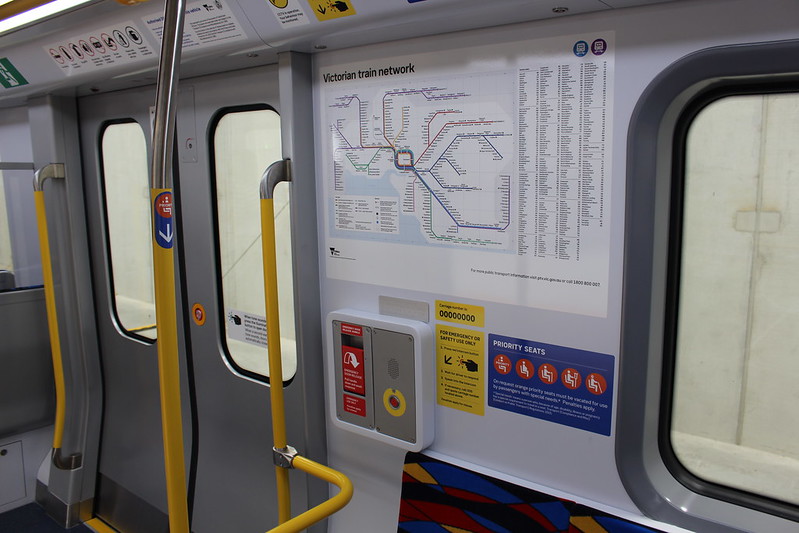
The connecting section between carriages is wider than existing trains, making it easier to move between carriages. I’m also told there will be more hand straps added — 3 per section rather than 2 as shown in this photo.
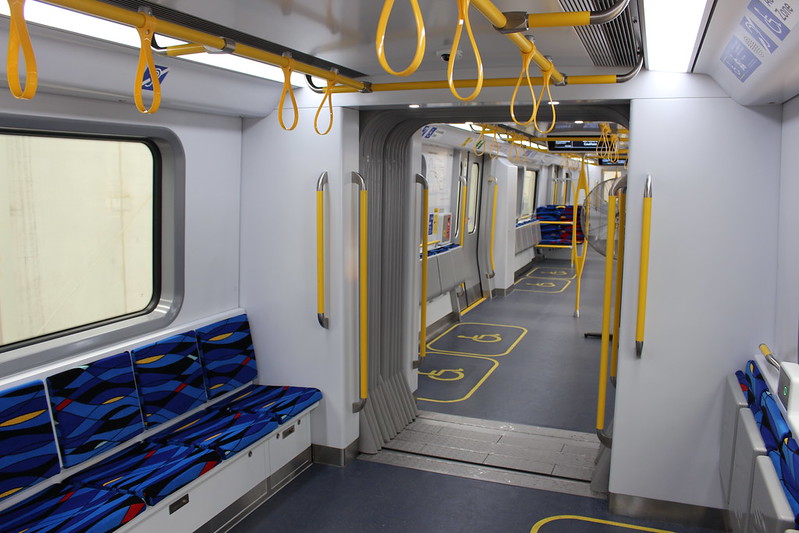
They tried different designs for the internal displays, and settled on white on black — feedback from stakeholders showed it’s clearer than the colour options they tested. They’ve got agreement from disability groups for the poles in the middle of the carriage adjacent the doorways, with recognition that these could be removed later if they cause issues for wheelchair users.
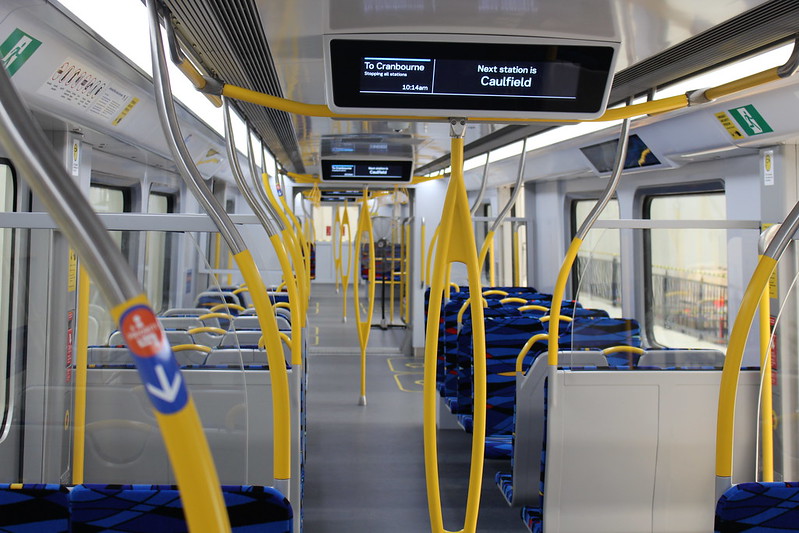
Doors have yellow highlights to assist the vision-impaired. Sections of some carriages are marked as preferred bicycle and pram boarding points. You might also spot the gutter along the top of the carriage near the roof. This will have a kind of mesh design on the top to prevent train surfers grabbing it.
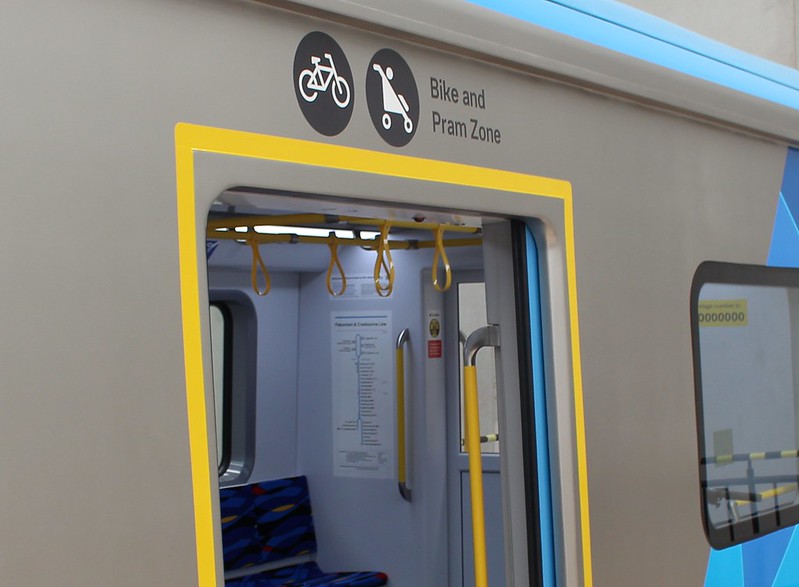
In the “bike zone” you’ll find velcro straps to secure bikes. Will these be used, and survive in the face of vandals? Hopefully. I guess time will tell.
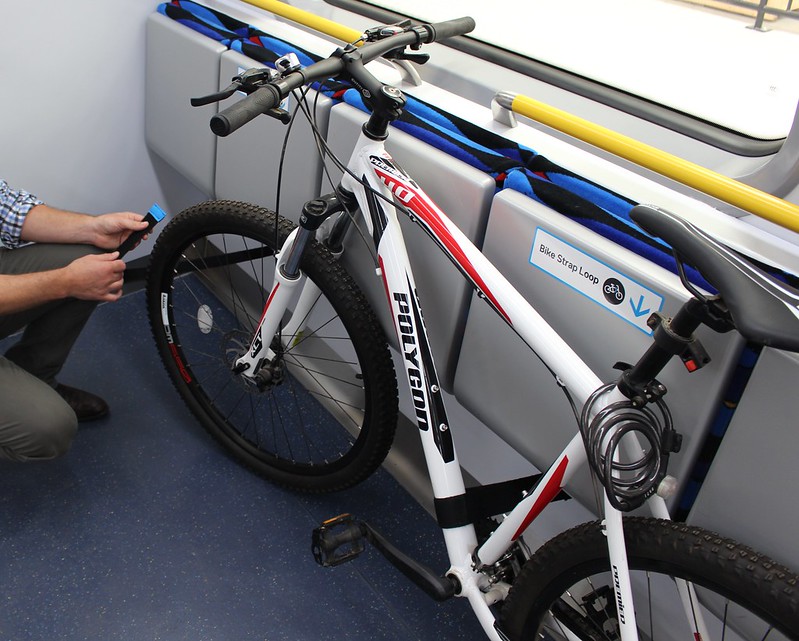
Decals above the doorway make it look more like a real train!
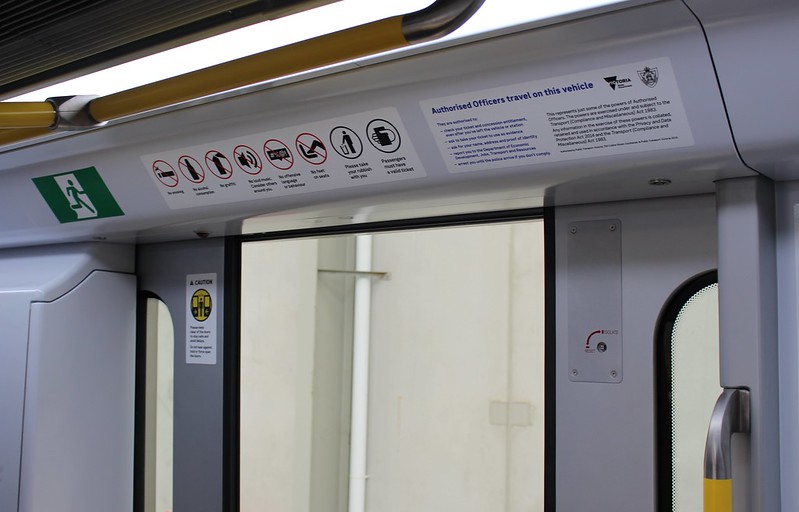
Here’s an exclusive tip for you, from a senior person on the project team: because of the internal cavity for the doors, the seats away from the doors are just very slightly bigger. So if in coming years you’re catching one of these trains and you’d like a tad more space, pick a seat further into the carriage!
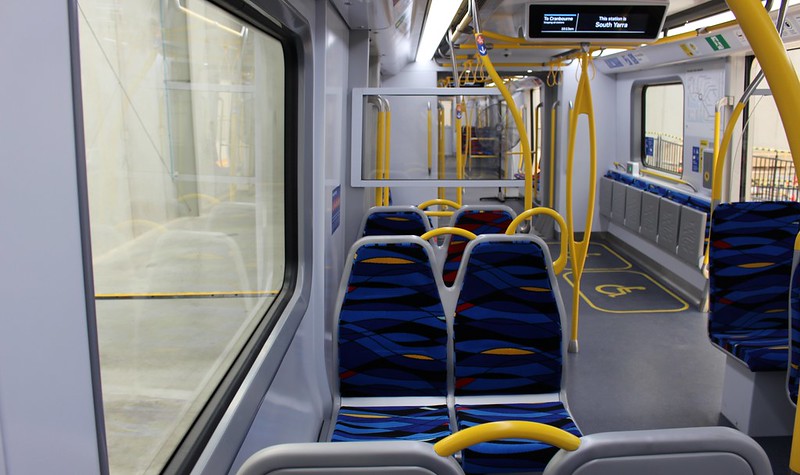
Edit: adding this pic to show one of the displays showing train position along the line.
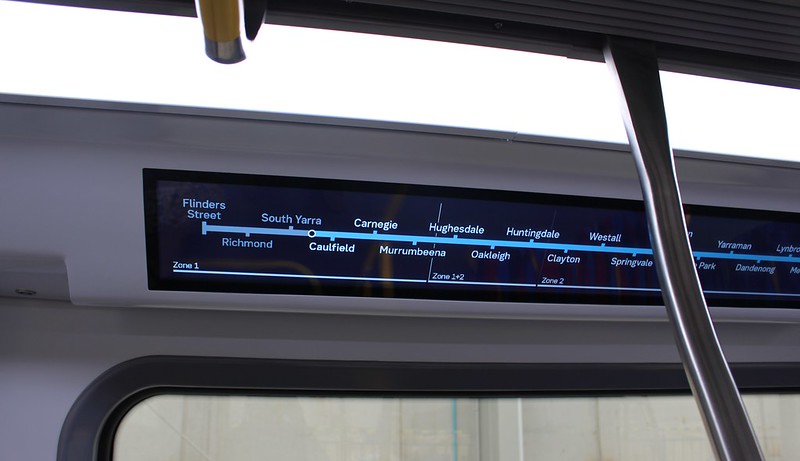
Overall I think it looks great, and the level of consultation has been far greater than on previous designs in the train fleet. Numerous groups, including PTUA, have been involved right through the process. A summary of the consultation is here.
The good news is you can see it yourself in February. From the 9th to 17th it’ll be on display at Birrarung Marr. Details here.
Thanks to the State Government and the project team for running the consultation.
- From 2015: Next gen trains are coming – what can we expect?
- PTUA’s involvement in projects like this is reliant on our volunteers and member funding. To support this work, please join, and even better — get active and join in!
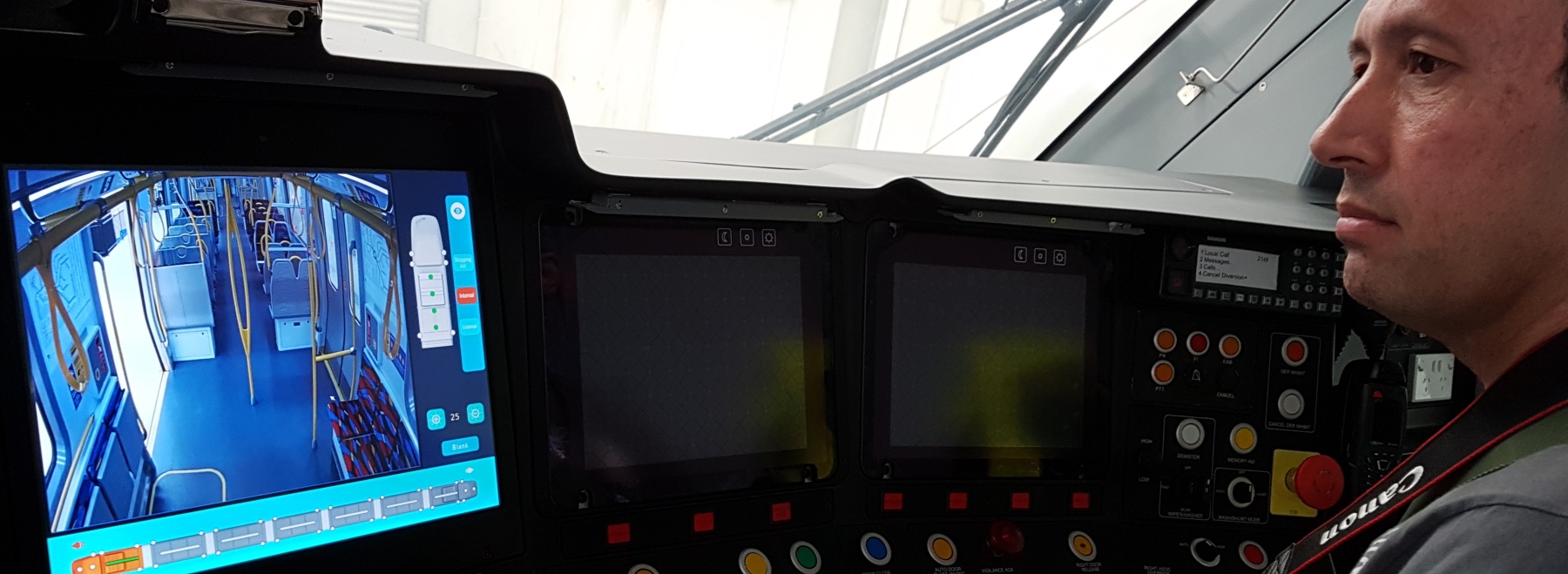
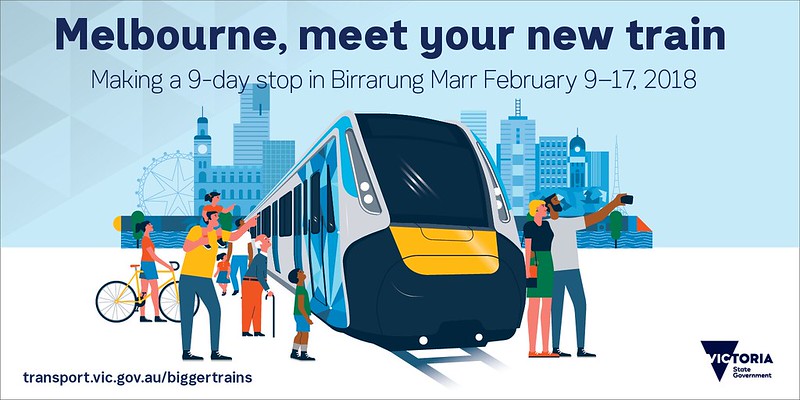
51 replies on “New metro train design finalised”
Thanks for the write-up. Good that the grab handles are close to the middle of the aisle rather than right over the bench seats. Don’t know how long the straps for bicycles would last. I’ll take a gander of the display carriage if I get a chance.
STILL no button to close the doors?? Other train systems have those, and on a freezing or rainy or stinking hot Melbourne day, they would be most helpful.
No electronic display showing the progress of the train along a particular line?
What’s the point in building a metro network with only 5 stations that’s laughable
I’m happy with more standing space (I stand anyway), but I sure hope these trains will offer a smoother ride than the X’Trapolis, which are much bumpier than the old Comeng and Siemens trains. It’s actually painful at times being thrown about when standing.
@Philip, I’m not sure that many other rail systems have Close Door buttons. Auto closing after ~60 seconds seems to be much more common.
@Andrew, there is such a display, on the wall above some of the windows. I didn’t include a photo this time because it hasn’t changed greatly since the October version of the mock-up, but you can just see it in the pic that highlights the other internal displays.
@Anonymous, it’s not a metro network of 5 stations. The tunnel connects the Sunbury line with the Cranbourne/Pakenham line, in a similar way that London’s Crossrail project connects existing lines via the city centre.
We need double decker trains to accommodate more passengers.
Pity you didnt adopt what Sydney has been doing for years in their designs, where you can pull the seats forward or back to sit in the direction of travel or make space for a group of friends.
The new trains look great. This is just an idea, but would it be possible to have some sort of ramp automatically extending out of the doorway covering the gap between the train and the platform and ensuring that there would be few delays with disabled people getting on board?
The train is a copy from Hungry Budapest.
The government should consider building a metro tunnel under HODDLE st Between CLIFTON HILL station to ELSTERNWICK STATION
Certainly looks good and suitable for our growing city. Lets hope that people will learn to move into the carriage away from the doors which will speed up loading and unloading, this is a big problem with current trains. The complete walk through is great, that’s one reason why I like the Siemens because one can walk through at least three carriages. The total walk through is long overdue as the two centre motor carriages were seldom used as driver units except in the workshops. I experienced the total walk through while in Europe some 17 years ago.
It looks as if there are no hanging loops in the normal (i.e. blue) seat areas. While I’m not a fan of loop hangers since they swing about too much, they are better than nothing.
Re above comment – I obviously meant in the sections with pairs of seats facing each other.
Will the new train have air bag suspension (like the Siemens trains) or leaf spring suspension (like the Xtrapolis) ? I would hope the smoother ride of air bag suspension would pay for itself over the life of the train through reduced track maintenance and higher patronage.
X’Trapolis trains have coil springs. Leaf springs were last used in the red rattlers.
I noticed a new ad for the Night Network on Channel 9 just before. Yes, on a Wednesday when it doesn’t even run. I swear the Victorian Government spends more on advertising than actually improving anything. The Nissan Qashqai (is that supposed to mean Cash Cow?) was advertised shortly after, showing the only alternative to the lacklustre public transport we have in this state.
It’s nice and I guess it ticks all the boxes regarding adding capacity and being DDA compliant, however the train is very basic in design.
There doesn’t appear to be any forward thinking, like being driverless, having electronic displays for advertisements, interchangeable seats (like Sydney trains have) or an interactive map that highlights the trains location on a line during travel. Yes, they need to serve their core function to add capacity to the network, but a metro-style network needs a metro-style train, not some commuter space wagon on wheels.
Great news! Thanks for the update Daniel.
Regarding the bike zone, will seated passengers have to give up their seats for a person with a bike like passengers need to do for a wheel chair person in the disabled area?
If not, will the bike person need to remove his bike to allow passengers to use the seats?
Hence forth shall be known as ‘Daffy Ducks’.
The photo with the bike looks like the bicycle is blocking use of 4 or 5 seats. That’s not good for paying passengers to encounter.
I’m tipping the Velcro straps for bikes will never be used, because they’re in a seating area that will always be occupied. It’s similar to the farcical notion that fold-up seating areas provide more space for standing passengers. By longstanding convention in Melbourne, all seats are occupied before standing room, and once seated, nobody stands up to make more room for standing.
To use the full capacity and minimise dwell times it’s *essential* to encourage standing passengers to move right inside, not to hang around near doorways. The mockup seems to be a bit of a curate’s egg in this regard.
Crosswise hand rails near doors (example in the CCTV photo) need to be set back so that the young buck who takes one step onto the train and plants his backside against the nearest one isn’t immediately blocking half the doorway. As shown in photo 7. But this seems to be inconsistent – see the CCTV photo.
Seats need to be set back from doors for the same reason, but this hasn’t been done (photos 6, 9). The seats nearest the doors in photos 6 & 9 should be removed and the windbreak panels should be moved away from the doors (with appropriate hand rails of course, as in photo 7).
Having blocks of front-to-back seating (like the Siemens trains, contrasting with older all front-to-front designs) is good, not least because it maximises the places for seat-back-corner hand holds. But it seems (photos not quite clear) that only half the seat back corners actually have hand holds. Why? You can’t have too many handholds.
There should be straps or ceiling-mounted rails *over the aisles*, not in a position that requires you to lean over the aisle seat. I realise there are probably structural issues here, but in a completely new design why wouldn’t you put an appropriate structural support for these right down the middle of the car?
@ Reuben: Auckland’s trains have an extending ramp: see https://www.youtube.com/watch?v=OejJf5TujMY at 1:20. I think it’s on one door or maybe one car per three-car set, but not sure about that. It does increase the mechanical complexity and the dwell time, so there are pros and cons.
@ Leo: Sydney’s double deck trains have about the same people-per-hour capacity as Melbourne’s trains, once you consider that 1. their nominal standing capacity cannot be achieved in practice because the doorways become congested long before the upper and lower cabins are filled; 2. they have a lower trains-per-hour capacity because of longer peak dwell times.
Double deck trains are good for maximising peak direction seats for longer suburban trips. Around the world, that’s where you’ll mostly see them. They’re not good for running a cost-effective, all-day, any-time-any-place mass transit service, which is where the growth potential is for rail in cities like Sydney and Melbourne.
The average Sydney train is full for maybe four trips a day, then spends the rest of the day using heavy and costly equipment to provide off-peak services that don’t need more than a small fraction of its capacity. That’s one reason why Sydney’s trains have poor farebox cost recovery, which is unfortunate because at the political level it’s a brake on proposals to provide better services.
I think it was a mistake for Sydney to go double-deck and I’d encourage Melbourne not to copy it.
@John where do you get any of this info? Do you ever take trains in Sydney??
It was hinted in the tender documents with their “mixed use spaces” that the bicycle facilities would be co-located with folding seats, and now we see that is exactly the plan. So this layout has even less space to place bicycles than the existing trains and instead people with bicycles (close to 1% of the passengers) are now competing with already limited seating capacity. Even asking standing passengers in the existing open areas to move and make space for a bicycle is unlikely to get their co-operation, so having a bicycle remove seats is a complete non-starter.
Its like how some councils paint bicycle lanes down their parking bays and claim to be addressing the needs of cyclists, despite that there are cars parked in the spaces all hours of the day leaving no space to cycle. Another tick box on the list of things to do but no real infrastructure for cycling.
@Ron
I’ve been using Sydney trains regularly since 1969. My knowledge is based on personal observation, stopwatch in hand, over many years, and simple arithmetic. For example:
Capacity of the line (trains per hour): A. Free running headway (signal clearance time if there were no stops) in the inner area: 80-90 seconds. B. Peak period peak station dwell: double deck, up to 90 seconds; a single deck train competently designed to minimise dwells, up to 60 seconds. Actual practical signal clearance time (A+B): DD 180 seconds (20 per hour); SD 150 seconds (24 per hour).
Capacity of trains: total capacity (sitting and standing) at 3 per square metre: DD about 1600; SD about 1300 [note 1]
Capacity of the line (people per hour): DD 20×1600 = 32,000. SD 24X1300 = 31,200
Farebox cost recovery: Sydney Trains 2015-16: 19 per cent. Melbourne: I can’t put my finger on a recent source but I believe it’s about 30 per cent [note 2]. It’s hard to know whether the Sydney and Melbourne figures are calculated on the same basis.
[1] 3 per square metre is less than a crush load but is a desirable maximum to allow free movement, which is important for reducing dwells. As sitting passengers are also at about 3 per square metre, total capacity may be estimated as simply 3x the floor area. The practical capacity of DD trains is less than this calculation would suggest because the doorways become congested well before the upper and lower cabins are filled.
[2] Sydney: IPART, Cost recovery: draft information paper 12, p. 4. Melbourne: BITRE information sheet Urban public transport: updated trends, 2014 (p.10) gives 30 per cent for Melbourne public transport in total. The figure for Sydney public transport in total is 21 per cent (IPART)
A couple of people have mentioned indicators showing where the train is. They are there; they’re just visible in some photos, but I’ve added one that specifically shows one.
@meltdblog: “people with bicycles (close to 1% of the passengers)”
Got a cite for that? That would make it 9 bicycles per peak hour train. I don’t think it’s anywhere near that high.
I have my doubts about the bicycle straps. I suspect what we’ll see is bike users aim for any section of the train with longitudinal seats (as per the diagram, there are quite a few of them).
It’s great having the display showing current location on the line. I note that it must be an express from South Yarra to Caulfield as it doesn’t show the stations in between.
It would be great to still show those, however in grey, or perhaps a big bright yellow arrow to show that, yes, you are on the right line, but you just won’t be stopping at those stations.
I’m taking the figures from PTVs passenger activity data, which they put cycle access at 0.7% some of that may be including bicycles parked at stations but if you sit and count boardings most people appear to take their bicycles onto the train. It also appears to be an underestimate as 2011 census data had 0.9% of commutes using trains including a bicycle component. People with bicycles are asked to avoid peak hour travel so their occupancy is shifted to other times of the day, its routine to see multiple bicycles in the vestibules so 9 per train does not sound improbable at all. When I take a bicycle on the train its common to change entry doors to avoid other bicycles or passengers with large luggage/prams etc.
Thank you for such an interesting post. It is a shame that the truth of the matter is that these trains are already well into production and this public consultation process of nothing more than showmanship. The designs have already been approved for months and are now handled by the se company that built the Hong Kong train network. So much for the Victorian governments’ precious lie.
With all of those disabled areas (assuming every “T” carriage is exactly the same), one hopes the platforms will actually be the correct height and without being a foot from the train so they can actually get on and off without having to go all the way to the first carriage. If the platforms are anything like Glenferrie once the trains are here it’s a 100% fail.
Re the emergency stairs.
What about people in wheelchairs?
The current train, is designed to permit an additional three cars to be added to each train, making it ten in total per train. Wonder when that may happen?
I somewhat agree with the white text on black background. In fact, white text on any background tends to work well.
I remember those CRO screens in the city. The ones on the above ground station platforms, they where shit. The foreground was almost as dark as the black. Meanwhile, the ones in the foyers, had different backgrounds, but all white text. In any case, that is another story.
[…] Park station has an island platform, designed to cope with the new 7-car High Capacity Metro Trains when they come into service next year. There seems to be provision for extending the platforms for […]
[…] Some have said this is too long for trains with few seats. The new High Capacity Metro Trains will have more standing space, but with more carriages as well, and an overall slightly higher number of seats than the current […]
[…] 24/1/2018 — The design was finalised in January 2018. Click through for pics. […]
Hi Daniel – on Wikipedia it is reported that the new trains will be equipped with wifi, which is linked back to one source in an online news article more than 12 months old. I haven’t seen this anywhere since. Do you know whats happening with this?
[…] evening and weekend trains were 3-cars, but 6 is now standard. The new HCMT fleet is being built without intermediate driver cabs, which will allow more passenger […]
Please have interchangeable seats in the design much like Sydney trains have.
Grinding on other people’s knee caps isn’t fun and it’s impossible to work with nothing in front to cradle the laptop to.
Also if someone’s sick, god bless you. Your almost guaranteed to get it passed down.
I’m not sure who’s bright idea it was to have facing seats but I think it’s a really really bad idea.
[…] retired next decade, and the government tells me they see benefit in having trains other than just HCMTs — probably makes sense given the large size of the fleet, the problems in the past when much […]
[…] This is all due to works for the metro tunnel near South Yarra station, in preparation for building the tunnel portal there. There are also works preparing the Dandenong line for the High Capacity Metro Trains. […]
[…] what about the future “High Capacity Metro Trains” (known as HCMTs for short – I think perhaps they need a snappier name). These are expected in […]
[…] past year or two, the Cranbourne/Pakenham rail line has seen numerous upgrades to prepare for the High Capacity Metro Trains to start this […]
[…] trains are coming into service in the next few months as the first HCMTs come online, so the fleet is set to grow in […]
[…] The new trains are expected to go into service later this year, 100 years after Melbourne’s first electric trains started running. […]
Centennials is a great name.
Like the bike securing straps.
Mike
Hi Daniel Bowen this isn’t related to this but will the Comeng ever run on the belgrave/lilydale lines? and if you could only say yes or no how come?
@Luke – back in 2016 there was a regularly rostered Comeng train on the Belgrave line:
https://railgallery.wongm.com/page/search/operated%20by%20Comeng%20trains
Of course Comengs used to run on the Ringwood lines all the time.
But it’s not hard to understand why they’d prefer to have specific types of train on one set of lines – consistency of speed/acceleration, ease of maintenance, even consistent door locations allowing the markings on platforms 7+8 at Richmond.
Rubbish. Seats look like primary school chairs. Just returned from Finland and their trains are fitted with toilets, comfy seats and are whisper quiet with digital live scheduling with connecting bus and tram timetables.
[…] below is from a document discussing CBD station capacity implications from the introduction of the High Capacity Metro Trains. I’m told the document is […]